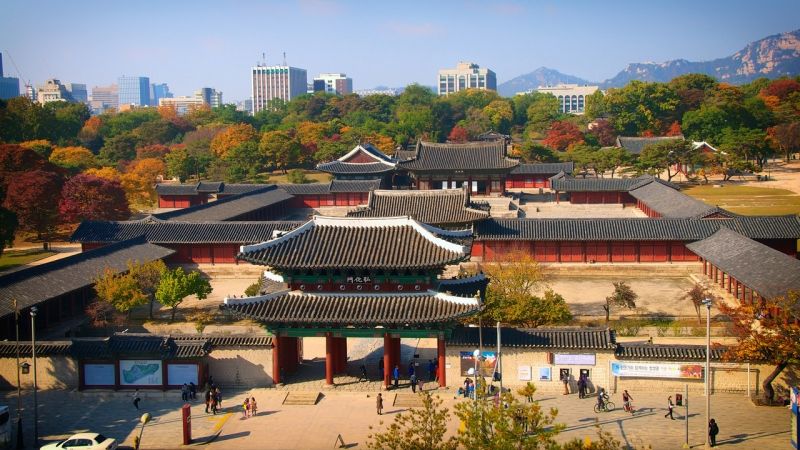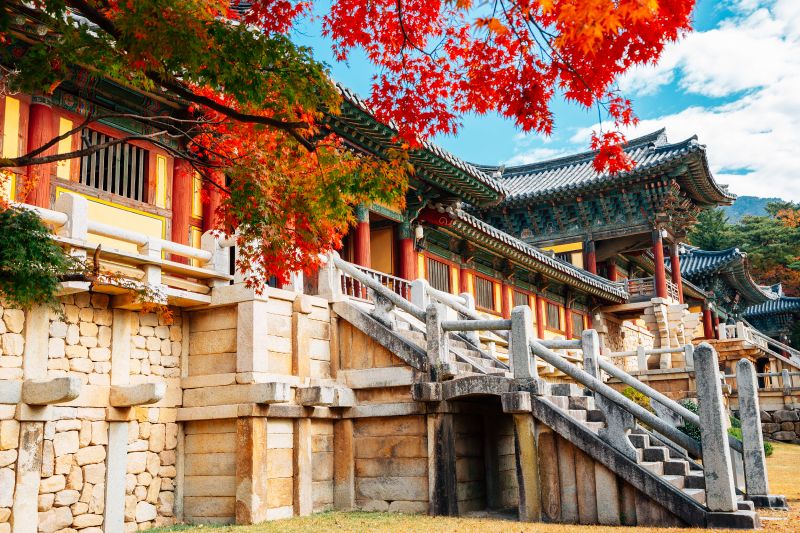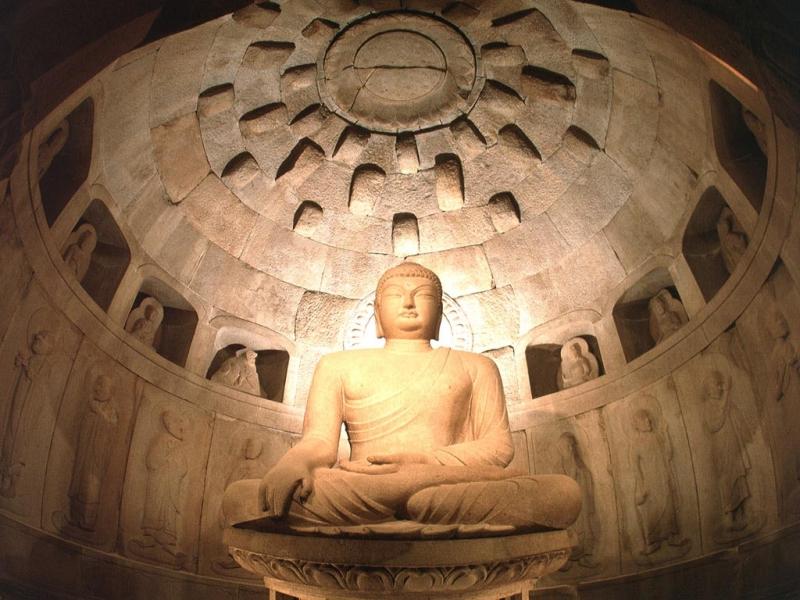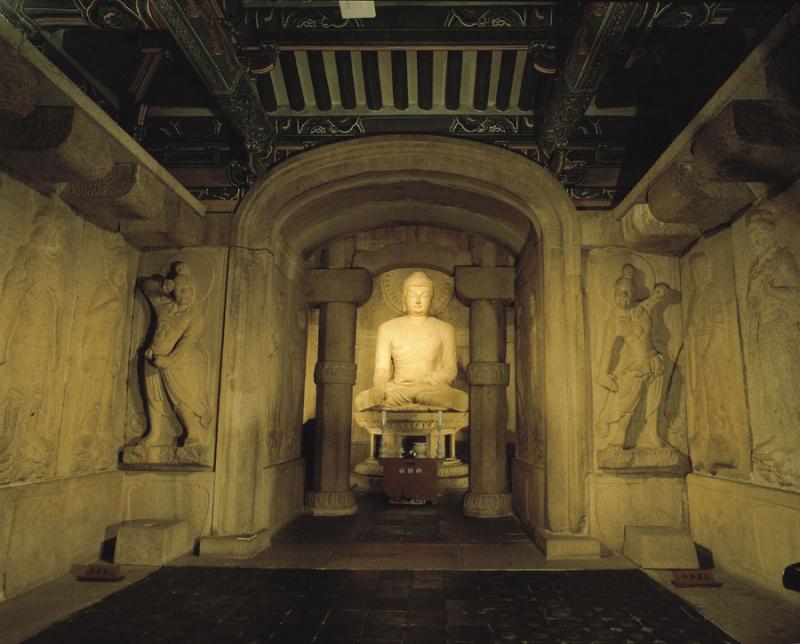Top most famous architectural works in Korea #1
Like a gentle love story of dramas in the land of kimchi, traditional Korean architectural style is a harmonious combination of elegant aesthetics and the gentle beauty of nature. Koreans often focus on using neutral colors, originating from the surrounding natural landscape to create the quintessence of ancient to modern architecture.
Gyeongbokgung Palace Located in the heart of the magnificent capital Seoul, the ancient Gyeongbokgung Palace is considered the most famous architectural symbol of the land of kimchi. Construction began in 1392, this place was once the living space of the royal family and held court meetings during the historical era of the powerful Joseon Dynasty. The overall planning of the palace includes three main areas: Main court area, common living area and rest area. The most important place of the palace is Can Chinh Palace, which is seen first when entering the main gate of Gwanghwamun. This is where royal court events took place and was also the living space of the king and queen at that time. With the exemplary architectural beauty of Asian style combined with soft lines inspired by peaceful nature, Gyeongbokgung monument is truly a marvelous masterpiece in Korea's architectural treasure.
Located in the heart of the magnificent capital Seoul, the ancient Gyeongbokgung Palace is considered the most famous architectural symbol of the land of kimchi. Construction began in 1392, this place was once the living space of the royal family and held court meetings during the historical era of the powerful Joseon Dynasty. The overall planning of the palace includes three main areas: Main court area, common living area and rest area. The most important place of the palace is Can Chinh Palace, which is seen first when entering the main gate of Gwanghwamun. This is where royal court events took place and was also the living space of the king and queen at that time. With the exemplary architectural beauty of Asian style combined with soft lines inspired by peaceful nature, Gyeongbokgung monument is truly a marvelous masterpiece in Korea's architectural treasure. The campus of Canh Phuc Palace has a flower garden and grass garden that are regularly and artistically trimmed, typical of Korean garden art. That is due to the combination between the beauty of nature and the labor of humans. If visitors visit on the right occasion, they will witness the military parade ceremony in the palace to depict a heroic part of the ancient dynasty. As the place where all the main activities of the Court are held, where the king and mandarins hold court, and receive embassies - Can Chinh Dien is the highest and most main palace of the Canh Phuc palace. Khanh Hoi Lau is the most beautiful place in the Korean Gyeongbokgung Palace. This place is often used to organize banquets, dances, and music to entertain foreign envoys. Khanh Hoi Lau is built in a two-storey architecture. The first floor is decorated with dragons and flowers, formed by 48 stone pillars. The first floor is for low-ranking mandarins and the second floor is for kings and foreign ambassadors.
The campus of Canh Phuc Palace has a flower garden and grass garden that are regularly and artistically trimmed, typical of Korean garden art. That is due to the combination between the beauty of nature and the labor of humans. If visitors visit on the right occasion, they will witness the military parade ceremony in the palace to depict a heroic part of the ancient dynasty. As the place where all the main activities of the Court are held, where the king and mandarins hold court, and receive embassies - Can Chinh Dien is the highest and most main palace of the Canh Phuc palace. Khanh Hoi Lau is the most beautiful place in the Korean Gyeongbokgung Palace. This place is often used to organize banquets, dances, and music to entertain foreign envoys. Khanh Hoi Lau is built in a two-storey architecture. The first floor is decorated with dragons and flowers, formed by 48 stone pillars. The first floor is for low-ranking mandarins and the second floor is for kings and foreign ambassadors.
Bulguksa Buddhist Temple Built during the Silla Beopheung period, Bulguksa temple had a strong impact on the lives of people at that time. At that time, Buddhism was considered the state religion in Korea, which is why the project received a lot of attention and was built quite elaborately. To decorate the temple, people use small sized stones to create shapes with motifs commonly used in temples such as lotus flowers, sky, birds... with iridescent colors symbolizing the floors. aristocratic class. This is considered a masterpiece representing the golden age of Buddhism in Korea. Through the ups and downs of history, the temple has also been destroyed many times, so it is no longer as it was at the beginning, but it still attracts tourists as well as researchers to visit.
Built during the Silla Beopheung period, Bulguksa temple had a strong impact on the lives of people at that time. At that time, Buddhism was considered the state religion in Korea, which is why the project received a lot of attention and was built quite elaborately. To decorate the temple, people use small sized stones to create shapes with motifs commonly used in temples such as lotus flowers, sky, birds... with iridescent colors symbolizing the floors. aristocratic class. This is considered a masterpiece representing the golden age of Buddhism in Korea. Through the ups and downs of history, the temple has also been destroyed many times, so it is no longer as it was at the beginning, but it still attracts tourists as well as researchers to visit. Like other temples, Bulguksa has a simple beauty, giving people a feeling of peace. Inside the temple, many precious Buddhist heritages are preserved. Because of the above characteristics, Bulguksa was recognized by UNESCO as a world heritage site in 1995. Come visit Bulguksa once, admire the scenery here, feel the elaborate masterpiece and the true soul. With the love of a child for his parents, surely each of us will receive unique values that can only be found here. In addition, the temple is also a place to worship 7 Korean mascots such as the Dabotap Stone Tower, the Blue Cloud Bridge, the gold-plated Buddha statue... This exquisitely sculpted stone masterpiece is recognized by UNESCO as a UNESCO World Heritage site. world cultural heritage in 1995.
Like other temples, Bulguksa has a simple beauty, giving people a feeling of peace. Inside the temple, many precious Buddhist heritages are preserved. Because of the above characteristics, Bulguksa was recognized by UNESCO as a world heritage site in 1995. Come visit Bulguksa once, admire the scenery here, feel the elaborate masterpiece and the true soul. With the love of a child for his parents, surely each of us will receive unique values that can only be found here. In addition, the temple is also a place to worship 7 Korean mascots such as the Dabotap Stone Tower, the Blue Cloud Bridge, the gold-plated Buddha statue... This exquisitely sculpted stone masterpiece is recognized by UNESCO as a UNESCO World Heritage site. world cultural heritage in 1995.
Thach Quat Am Seokguram Besides the Bulguksa National Temple, Shiguam Am Seokguram is also the most famous and exquisite Buddhist masterpiece built by a king of the ancient Silla Kingdom. In the beautiful and peaceful natural landscape, when silently admiring the exquisite beauty of the solemn Buddha statues here, we will feel the sincerity and admiration of the sculptors. thousand years ago. Only steadfast sincerity can carve solid marble rocks into such sophisticated and skillful works of art. With such historical and artistic value, Buddhist followers should not miss these two works when traveling to Korea.
Besides the Bulguksa National Temple, Shiguam Am Seokguram is also the most famous and exquisite Buddhist masterpiece built by a king of the ancient Silla Kingdom. In the beautiful and peaceful natural landscape, when silently admiring the exquisite beauty of the solemn Buddha statues here, we will feel the sincerity and admiration of the sculptors. thousand years ago. Only steadfast sincerity can carve solid marble rocks into such sophisticated and skillful works of art. With such historical and artistic value, Buddhist followers should not miss these two works when traveling to Korea.
Thach Quat Am (Seokguram) is not inherently a tourist area, this is a famous relic, a Buddhist land, a place where people cultivate their minds, reflect and reconsider themselves as well as those around them. around. During the Silla (Silla) era in Korea, about more than a thousand years ago, there was a boy named Kim Dae-seong (Kim Dae-seong) living in Moryang village, because his family encountered economic difficulties. , so he had to work here and there as a hired laborer in exchange for food and clothes and to help his family. One day, after attending a Dharma talk by a Dharma Master preaching Buddhist teachings, he immediately went home to convince his mother to donate the garden, the family's only property, to accumulate merit.




























